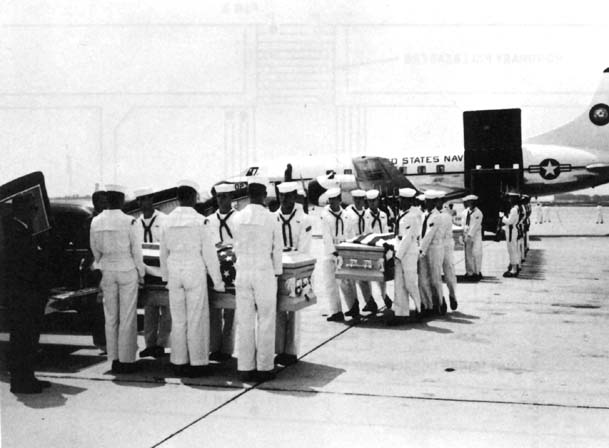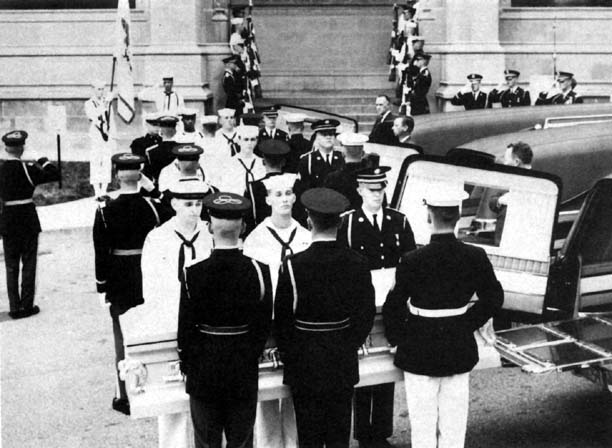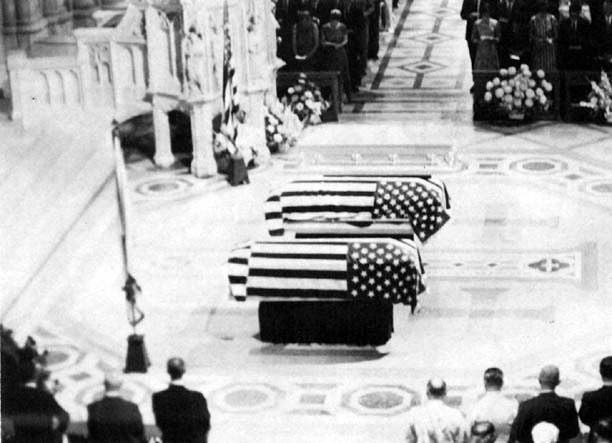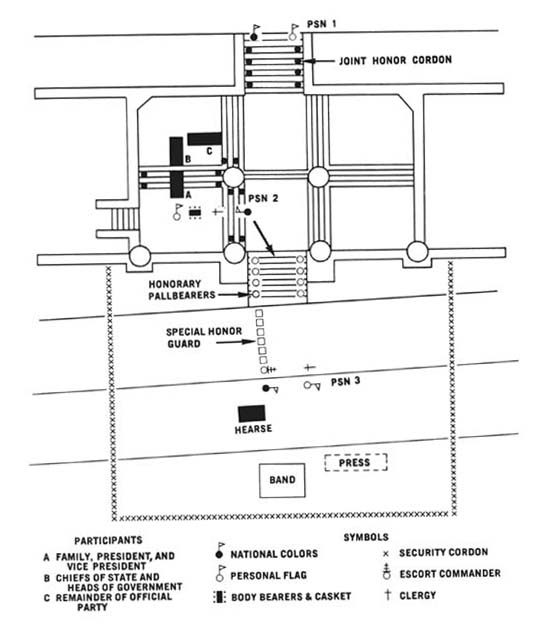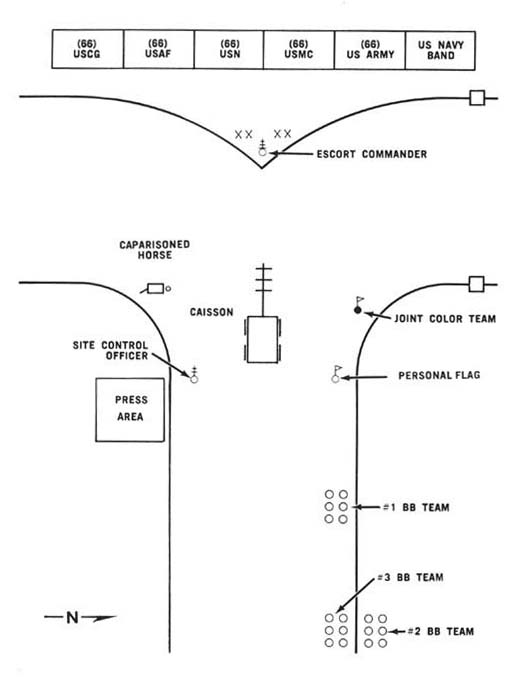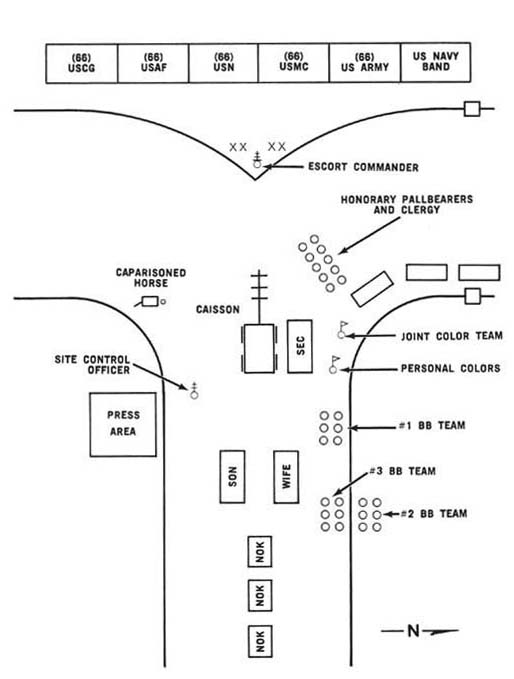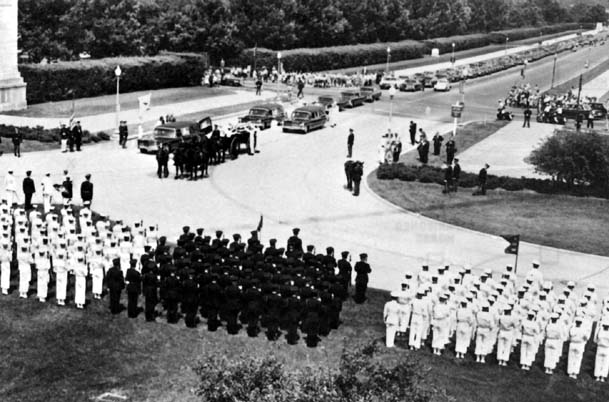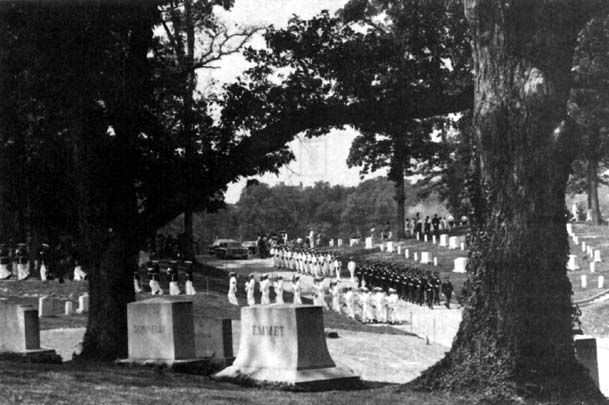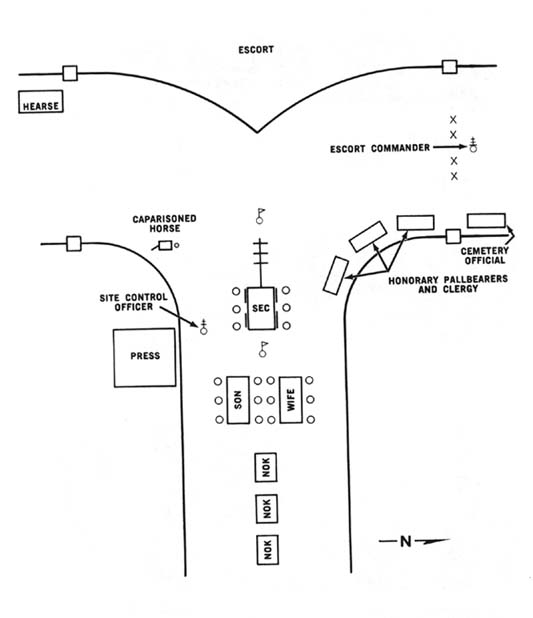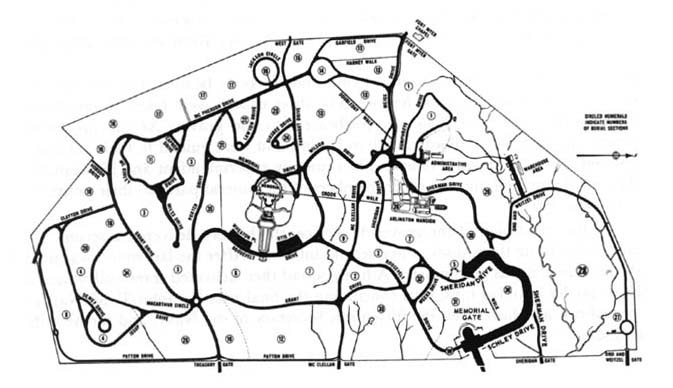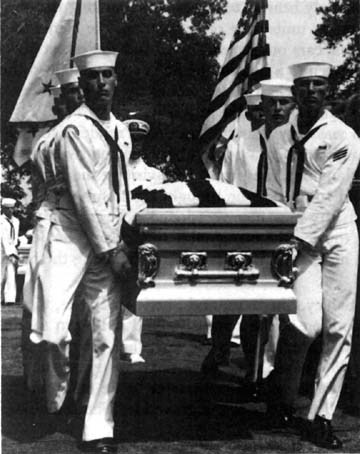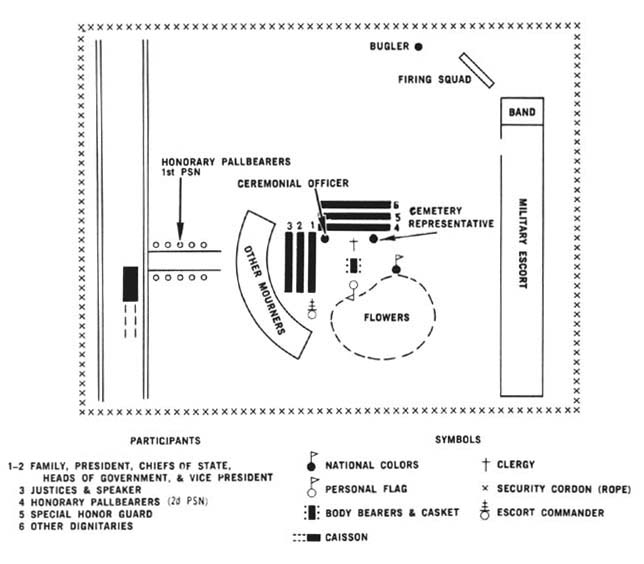The Last Salute: Civil and Military Funeral, 1921-1969
CHAPTER XXVII
Secretary of the Navy-Designate John T. McNaughton,
Sarah McNaughton, and Theodore McNaughton
Special Military Funeral
19-25 July 1967
Near noon on 19 July 1967, a Piedmont Airlines Boeing 727 and a private
plane that was off its course collided and exploded over the Blue Ridge
foothills in western North Carolina near Hendersonville, not far from
the city of Asheville where the Piedmont plane had taken off only minutes
before. All persons aboard both planes were killed. Among the passengers
on the airliner were Secretary of the Navy-designate John T. McNaughton,
his wife, Sarah, and the younger of his two sons, Theodore.
Mr. McNaughton was to have taken office as Secretary of the Navy on 1
August. At the time of his death he was Assistant Secretary of Defense
for International Security Affairs, a post he had held since 1964. As
Department of Defense officials considered formal funeral honors for Mr.
McNaughton, a question arose as to his exact official status at the time
of his death. As Assistant Secretary of Defense, he was entitled, under
existing policies, to an Armed Forces Full Honor Funeral. As Secretary
of the Navy, he was entitled to the more elaborate ceremonies of a Special
Military Funeral. The decision, based on the fact that the Senate had
confirmed his appointment as Secretary of the Navy, was that Mr. McNaughton
was entitled to the greater honor of a Special Military Funeral.
Secretary and Mrs. McNaughton were survived by their eighteen-year-old
son, Alexander, their parents, and the Secretary's two brothers and his
sister. In consultations between Department of Defense officials and the
next of kin, it was tentatively decided that a funeral service for Secretary
McNaughton, his wife, and his son would be held in Pekin, Illinois, where
the Secretary's parents resided, and that burial would take place in Arlington
National Cemetery. Mr. McNaughton was eligible for burial in a national
cemetery by virtue of World War II service as a commissioned officer in
the Navy. Mrs. McNaughton also had served during World War II as an ensign
in the WAVES. The final decision, however, was that a funeral service
for the three members of the McNaughton family would be held in Washington,
D.C., at the Washington National Cathedral on 25 July, with burial in
Arlington Cemetery.
[309]
The commandant of the Naval District Washington, Rear Adm. Elliott Loughlin,
would automatically have become responsible for completing funeral arrangements,
in accordance with the current policy that the responsibility fell to
the service with which the deceased had been associated. But at the specific
request of the Naval District, the Commanding General, Military District
of Washington, Maj. Gen.Curtis J. Herrick, accepted the responsibility
for arranging and co-ordinating the ceremonies.
According to the plan, a Navy transport plane was to bring the bodies
of Secretary and Mrs. McNaughton and their son from North Carolina to
Andrews Air Force Base on 24 July. From there, the bodies were to be taken
to Gawler's funeral establishment in Washington, DC A joint service arrival
ceremony, based on the current prescriptions for a Special Military Funeral
published in 1965, was to be conducted at the airfield. But since the
arrival and transfer of the bodies to the funeral home were considered
primarily administrative moves, some of the usual procedures of an arrival
ceremony, including the presence of a band, special honor guard, and honorary
pallbearers, were to be eliminated.
The site control officer at the field was to be from the 3d Infantry.
One officer and thirty-eight enlisted men of the Navy were to form a security
cordon surrounding the ceremonial area, and the Navy was also to furnish
three body bearer teams of six men each (plus two supernumeraries) and
the petty officer in charge. A joint honor cordon, which would line the
route from the parked aircraft to the three hearses from Gawler's, was
to be commanded by a Navy officer and to include eight men each from the
Army, Marine Corps, Navy, Air Force, and Coast Guard. An Army color bearer
and a guard each from the Marine Corps and the Air Force would make up
the national color detail; the personal flag bearer would be a Navy man.
The plane bearing the bodies of Secretary McNaughton and his wife and
son landed at Andrews field a few minutes after 1400 on 24 July. When
the lift truck was brought up to lower the caskets from the plane, it
was discovered that the platform would hold only two of the three caskets.
The body bearer teams were consequently under considerable strain, being
obliged to hold the first two caskets while the third was removed from
the plane separately. The caskets were then carried in procession through
the joint honor cordon to the hearses and taken to Gawler's funeral establishment,
where they remained until the funeral service at the Washington National
Cathedral on 25 July.
The service was held at 1300. During the morning of 25 July, troops that
were to support or participate in the ceremony reported to the site control
officer, who was from the 3d Infantry, at the cathedral. After briefing
and rehearsal, all troops were in position by 1230. A security cordon
of one officer, one noncommissioned officer, and thirty-five enlisted
men from the 3d Infantry took post around the north transept entrance
of the cathedral to keep the ceremonial area clear. A parking and traffic
control detail of five officers, eleven noncommissioned officers,
[310]
CASKETS ARE PLACED IN HEARSES AT ANDREWS AIR FORCE BASE
and thirty-three enlisted men, also from the 3d Infantry, was on station,
with a member of the cathedral police and two members of the Metropolitan
Police assisting. A smaller detail of one officer, one noncommissioned
officer, and five enlisted men from the 3d Infantry was on hand to control
the movement of members of the press. One of the earliest to arrive at
the cathedral was a detail of six men furnished by the Navy to handle
all floral pieces.
An Army officer was in charge of a joint service detail of seventy-five
officers and men (one officer, two noncommissioned officers, and twelve
men from each service), who were to escort those attending the cathedral
service to their seats. Escort officers also were present to assist and
guide the honorary pallbearers during the ceremonies.
Persons invited to attend the service began to take their places in the
cathedral about half an hour before the scheduled time. Members of the
McNaughton family arrived at 1250, the honorary pallbearers, Vice President
Hubert H. Humphrey and his party, and President Lyndon B. Johnson and
his party in the next ten minutes. The arrival of the family and dignitaries,
all at the north transept entrance and all at approximately the same time,
caused some confusion, but with
[311]
Diagram 103: Standard formation, arrival ceremony, Washington, DC
[312]
CASKETS ARE TAKEN INTO WASHINGTON NATIONAL CATHEDRAL
the help of the site control officer, who performed as an usher himself,
all were seated without undue delay.
The arrival ceremony was based on procedures in the 1965 policy book,
although no escort commander participated. (Diagram 103) The honorary
pallbearers, among whom was Secretary of Defense Robert S. McNamara,
formed a cordon on the steps of the north transept entrance to the cathedral.
A joint honor cordon of troops lined the remaining steps to the street.
At the foot of the steps stood the clergy, national color detail, and
personal flag bearer, and across the street, opposite the cathedral entrance,
the U.S. Marine Band was in formation. Nearby were three joint service
body bearer teams.
Ten minutes before the scheduled beginning of the service, hearses bearing
the bodies of the three members of the McNaughton family, accompanied
only by a police escort, arrived at the cathedral and halted in column
along the side of the driveway leading to the north transept entrance.
At the scheduled hour, they were driven to the north transept entrance
and parked abreast. The US Marine Band sounded ruffles and flourishes,
and as it began to play a hymn the three body bearer teams removed the
three caskets from the hearses simultaneously. They
[313]
FUNERAL SERVICE IN THE CATHEDRAL
were then borne in procession through the honor cordon into the cathedral,
the national color detail leading, the clergy, the caskets of Secretary
McNaughton, Mrs. McNaughton, and Theodore McNaughton and the personal
flag bearer following. Inside the cathedral entrance the caskets, those
of the Secretary and Mrs. McNaughton draped with flags, that of their
son undraped, were placed on movable biers and taken forward for the service.
Mr. Adam Yarmolinsky, who had been a deputy to Mr. McNaughton during his
tenure as Assistant Secretary of Defense, opened the funeral service by
delivering a eulogy. Religious services were then conducted by Canon William
G. Work man of the Washington National Cathedral, Dr. Joseph A. Mason
of the Grace Methodist Church (the McNaughton family church) in Pekin,
Illinois, and the Right Reverend Paul Moore, Jr., suffragan bishop of
Washington. Two hymns were sung during the service, one of them the Navy
hymn, "Eternal Father, Strong to Save." These were led by the
US Navy Band Sea Chanters. The service ended about 1345. The caskets were
then taken from the cathedral in procession, and the motor cortege, without
military escort, departed for Arlington National Cemetery. The departure
ceremony followed established procedure, but
[314]
Diagram 104. Standard formation, departure ceremony, Washington National Cathedral.
[315]
without the participation of an escort commander or special honor guard.
(Diagram 104)
According to plan, the cortege was to proceed to Memorial Gate of the
cemetery. There, before a military escort drawn up on the green, the casket
of Secretary McNaughton was to be transferred from the hearse to a caisson.
After the transfer ceremony, the military escort was to lead the cortege
into the cemetery to the gravesite in Section 5, northeast of the Custis-Lee
Mansion.
In preparation for the casket transfer at the cemetery gate, all troops
who were to participate in or support the ceremony were in position by
1330. The military escort included a Navy officer as commander, with a
joint service staff of four, and five companies of troops, one each from
the Army, Marine Corps, Navy, Air,Force, and Coast Guard. Each escort
company had a commander, two other officers, and sixty-three enlisted
men. The escort also included the US Navy Band. The entire formation was
on line on the lawn at the gate, facing Memorial Drive over which the
cortege would approach.
In front of and facing the escort, the caisson and caisson detail from
the 3d Infantry were in the center of Memorial Drive. To the left front
of the caisson a handler stood with a caparisoned horse that was to march
in the cortege through the cemetery to the gravesite. To the right of
the caisson stood a joint national color detail and a Navy enlisted man
with the personal flag of Secretary McNaughton. Along the edge of Memorial
Drive to the rear of the color bearers waited three body bearer teams,
all from the Navy. (Diagram 105)
On the lawn across the street from the body bearer teams, an area cordoned
by four enlisted men from the 3d Infantry had been reserved for members
of the press. Other supporting troops included a 3d Infantry parking detail
of one officer and four noncommissioned officers. These men were to guide
the vehicles of the cortege to their positions for the casket transfer
ceremony. Finally, one noncommissioned officer and twenty men from the
3d Infantry were posted as a security cordon to keep the ceremonial area
clear.
Near 1430, as the cortege approached Memorial Gate, the cars were halted
in a double column a short distance below the ceremonial area. Those carrying
the clergy and honorary pallbearers were then signaled forward and were
brought to a stop just after they turned north off Memorial Drive onto
Schley Drive. The clergy and honorary pallbearers then dismounted and
were guided to their positions for the transfer ceremony.
The three hearses and the cars carrying the family were next signaled
forward. The hearse bearing the casket of Secretary McNaughton was
halted to the right and even with the caisson; the other two hearses drew
up abreast immediately behind the caisson. Immediately behind them the
cars of the family were arranged in a single column. The family remained
in the cars while the casket transfer ceremony took place. (Diagram
106)
After the hearses and family vehicles had been brought forward, the three
[316]
Diagram 105. Formation at Memorial Gate for the casket transfer ceremony.
[317]
Diagram 106. Casket transfer ceremony, arrival of cortege.
[318]
MILITARY ESCORT RENDERS HONORS as casket of John McNaughton
is transferred
to caisson at Memorial Gate, above.
Military escort marches through cemetery, below.
[319]
Diagram 107. Formation at Memorial Gate after the casket transfer ceremony.
body bearer teams took position. One team moved to the rear of the hearse
bearing the casket of Secretary McNaughton. Those assigned to carry the
other two caskets took a position flanking the hearse, three men on either
side. The US Navy Band sounded ruffles and flourishes and the escort troop
units presented arms. The band then played a hymn.
While the hymn was played, the body bearers transferred, Secretary McNaughton's
casket from the hearse to the caisson. After the hearse was driven
[320]
away from the ceremonial area, the body bearers took positions flanking
the caisson, three men on each side. The escort units then ordered arms,
the clergy and honorary pallbearers returned to their cars on Schley Drive,
and the escort commander and his staff moved off the green to a position
on Schley Drive to lead the procession into the cemetery. Mr. John C.
Metzler, cemetery superintendent, meanwhile had arrived to guide the procession
to the gravesite. (Diagram 107)
Since the gravesite in Section 5 was very near the grave of President
John F. Kennedy, troops from the 3d Infantry formed a cordon between the
two sites to separate persons attending the McNaughton rites from those
visiting the Kennedy grave. Additional troops from the 3d Infantry, who
brought the number assigned to security duty to one officer and fifty-four
men, cordoned a larger perimeter around the McNaughton gravesite to keep
the ceremonial area clear. The 3d Infantry also supplied one officer and
nineteen men to control traffic along the route of the procession to the
gravesite.
As the procession marched via Schley, Sherman, and Sheridan Drives, the
3d Infantry battery, from its distant position in the cemetery, fired
a 17-gun salute, spacing the rounds so that the last was fired close to
the time that the procession reached the gravesite. (Diagram 108)
When they were near the gravesite, the Navy Band and one platoon of each
of the escort companies broke off from the formation and moved to their
assigned positions at the graveside. The remainder
Diagram 108. Route of march, Memorial Gate to gravesite.
[321]
NAVY BODY BEARERS CARRY CASKET OF JOHN MCNAUGHTON TO GRAVE
of the escort units, not scheduled to participate in the graveside ceremony,
continued to march, moving out of the ceremonial area to dismissal points.
When the cortege reached the gravesite, the caisson and two hearses were
halted near a cocomat runner leading to the graves. The national color
team moved to a position between the caisson and the gravesite and the
honorary pallbearers, after they had left their cars, were escorted forward
to form a cordon along the cocomat runner. The remainder of the funeral
party assembled behind the caisson and the two hearses.
At signals from the cemetery superintendent and the site control officer,
the escort units at the grave presented arms and the Navy Band sounded
ruffles and flourishes. The band then began a hymn and the body bearers
removed the caskets from the caisson and the hearses. The three caskets
were taken in procession through the cordon of honorary pallbearers to
the graves. As the procession passed, the honorary pallbearers fell in
behind and were guided to their graveside position by the site control
officer. The cemetery superintendent and his assistants then led the next
of kin and other members of the funeral party to their positions. (Diagram
109)
At the conclusion of the graveside service, the battery delivered a second
17gun salute, firing the rounds at five-second intervals. After the
last round was fired the benediction was pronounced. A firing squad then
delivered three volleys and a Navy bugler sounded taps, thus concluding
the final rites for John T. McNaughton, who would have been the fifty-ninth
Secretary of the Navy, and for his wife and son.
[322]
Diagram 109. Formation at the graveside (schematic ).
[323]
